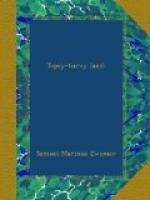The word means one “who stands before,” and was first used as a title for the leader of prayer in the mosques. In Oman the religious chiefs soon took hold of politics, and so the title has a significance now in this part of Arabia that it never had elsewhere.
Let us get back to the penny. Its face (although being a Mohammedan coin it really has no human face because their religion forbids pictures) bears an English as well as an Arabic inscription. The opposite side only has the Sultan’s name in Arabic. On the side that has the English words is the legend: “Struck at Muscat in the year 1315.” Yet the penny is only three years old, for the Moslems begin to date their years from the Hegira, or flight of their prophet from Mecca to Medina. This took place in the year 622 A.D. But we must also remember that their year is several days shorter than ours, because they have lunar months all of equal length and only 360 days in a year.
How strange it is to read such an old date for such a recent year as 1899, since we count time from the birth of Christ! But you must remember that the False Prophet has had it all his own way in Arabia for thirteen hundred years, and that the missionaries in this country are very few indeed. Only for a very few years and in a very few places has Christ been preached.
Now, however, even this queer little penny can bear witness to the fact that the gospel has come to Oman. It is worth one-quarter of an anna; there are sixteen annas in a rupee, and a rupee is worth about thirty-three cents. Not a big value, is it? But for four of these coins the poorest boy in Muscat can buy a complete gospel of Matthew. The shopkeeper must take in a great many of them, for last year one thousand four hundred and thirty-three such gospels and other portions of the Bible were sold in this part of Arabia and paid for by these coppers.




